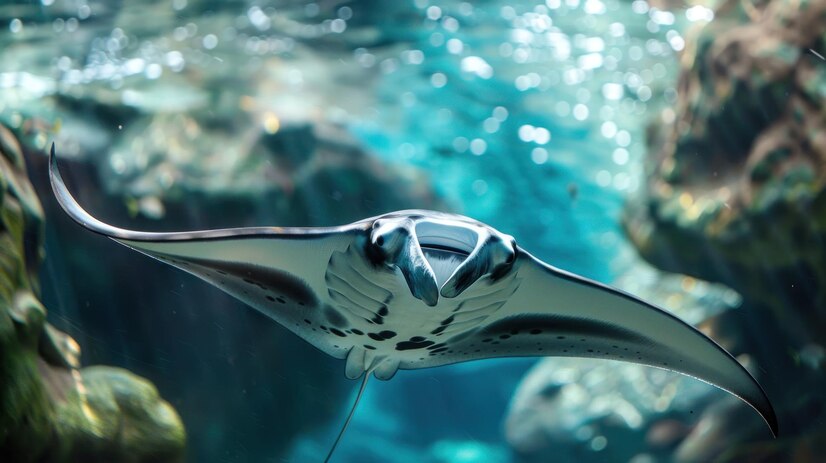The ocean is home to countless wonders, but few “Mantarraya Marvels” creatures capture our imagination quite like the Mantarraya Marvels . These graceful giants glide through the water with an elegance that feels almost otherworldly. With their wide wingspans and unique patterns, they are a sight to behold whether you’re snorkeling in tropical waters or watching from a boat above.
Mantarraya Marvels, often referred to as manta rays, evoke a sense of mystery and awe. They belong to the family Mantarraya Marvels and can be found in oceans around the world. But there’s much more to these magnificent beings than meets the eye. Dive into this blog post as we explore fascinating facts about mantarrayas—from their physical features and feeding habits to their interactions with humans and conservation efforts aimed at protecting them. Get ready for an adventure beneath the waves!
Physical Features and Characteristics
Mantarrayas are striking creatures, easily recognizable by their flattened bodies and broad wings. These graceful animals can span up to 29 feet across, though most species range between 5 to 23 feet.
Their skin is smooth and often features unique patterns that help in camouflage against ocean floors. The coloration varies widely—from muted browns and grays to vibrant blues or spotted designs—allowing them to blend seamlessly with their surroundings.
Another remarkable characteristic of mantarrayas is their long, whip-like tails. While some species have defensive spines on these tails, they generally prefer peace over conflict.
Beneath the surface, mantarrayas possess a pair of large eyes that allow for excellent vision even in low light conditions. Their mouths are located on the underside of their bodies, adapted perfectly for filter feeding as they glide through the water. This combination of physical traits makes them truly mesmerizing marine inhabitants.
Distribution and Habitat
Mantarrayas are found in warm, shallow waters around the globe. They prefer coastal areas, often frequenting bays and estuaries. This affinity for proximity to land allows them to thrive in diverse marine environments.
Typically, you’ll spot these graceful creatures near coral reefs or sandy bottoms. Their flat bodies glide effortlessly through the water, making them masters of their domain.
Regions like the Caribbean Sea and Indo-Pacific are hotspots for Mantarraya Marvels. They enjoy temperatures ranging from 20°C to 30°C (68°F to 86°F). This preference helps explain their distribution patterns worldwide.
Occasionally, they venture into deeper waters but generally stay close to shorelines where food is plentiful. The accessibility of these habitats plays a crucial role in their survival and reproduction strategies as well.
Feeding Habits and Diet
Mantarrayas are remarkable filter feeders. They glide gracefully through the water, mouths wide open, capturing tiny prey as they swim.
Their diet primarily consists of plankton, small fish, and crustaceans. With gill rakers that act like a sieve, these ocean wonders strain their food from the water effortlessly.
You can often find them in shallow coastal waters where food sources abound. Their feeding technique is not only efficient but also mesmerizing to observe.
Sometimes Mantarraya Marvels use their bodies to create currents that help funnel more food into their mouths. This unique behavior showcases their adaptability in different environments.
While they thrive on small organisms, Mantarraya Marvels play an essential role in maintaining marine ecosystems by controlling plankton populations. Each meal contributes to the balance of life beneath the waves.
Reproduction and Life Cycle
Mantarrayas exhibit fascinating reproductive behaviors. Most species are ovoviviparous, meaning they give birth to live young after the embryos develop inside eggs retained in the mother’s body.
Mating typically occurs during warmer months. Males often engage in elaborate courtship displays, showcasing their agility and strength to attract females.
After a gestation period that can last several months, females give birth to anywhere from two to six pups at a time. These tiny mantarrayas emerge fully formed, measuring about 12 inches across.
Once born, the pups quickly learn to navigate their environment. They rely on instinct and parental protection until they can fend for themselves.
Life starts off precarious for these young ones as they face numerous predators in open waters. The survival rate remains low due to various threats but those that do survive grow rapidly into majestic adults over several years.
Interactions with Humans
Mantarrayas have captured human fascination for centuries. These graceful creatures often grace divers and snorkelers with their presence, creating unforgettable experiences in the water. Their majestic gliding through ocean depths evokes awe and wonder.
Interactions can be both positive and negative. In many coastal regions, ecotourism thrives on swimming with mantarrayas. Responsible tourism practices help protect these gentle giants while providing memorable encounters for visitors.
However, not all interactions are beneficial. Overfishing and habitat destruction pose serious threats to mantarraya populations. Some areas see an increase in fishing nets that inadvertently ensnare these peaceful animals.
Education is key to fostering a respectful relationship between humans and mantarrayas. Raising awareness about their plight encourages conservation efforts that benefit both the species and our oceans’ ecosystems. By understanding how to coexist peacefully, we can ensure future generations enjoy the marvels of these magnificent beings.
Conservation Efforts and Threats
Conservation efforts for mantarrayas are crucial as these majestic creatures face numerous threats. Overfishing, bycatch, and habitat destruction significantly impact their populations. Many species of mantarrayas are caught unintentionally in fishing nets, leading to a decline in numbers.
Marine protected areas have been established to safeguard their habitats. These zones restrict harmful activities such as trawling and pollution, allowing mantarrayas to thrive in safer environments. Conservation organizations work tirelessly to raise awareness about the importance of preserving these oceanic wonders.
Climate change poses another challenge. Rising ocean temperatures can disrupt breeding patterns and food availability for mantarrayas. Efforts aimed at mitigating climate impacts include advocating for sustainable practices within coastal communities.
Education plays a vital role too. Engaging local fishermen and communities helps promote coexistence with these gentle giants while fostering appreciation for marine ecosystems’ health.
Fun Facts about Mantarrayas
Mantarrayas are more than just graceful swimmers. These creatures have an incredible ability to leap out of the water, sometimes reaching heights of up to 10 feet. This spectacular breach is often thought to be a display or a way to shake off parasites.
Did you know that mantarrayas can weigh over 1,500 pounds? Despite their size, they are gentle giants known for their friendly demeanor. Their wide mouths allow them to filter feed on plankton and small fish while gliding effortlessly through ocean waters.
Some species exhibit unique patterns on their skin, akin to human fingerprints. Each pattern is distinct, making them easily identifiable in the marine world.
Additionally, mantarrayas possess remarkable intelligence. They can recognize themselves in mirrors and show signs of curiosity about their environment. Such traits contribute to our fascination with these incredible oceanic wonders!
Conclusion
Mantarrayas are truly remarkable creatures that capture the imagination. Their graceful movements through the water evoke a sense of wonder.
These gentle giants hold secrets about our oceans and ecosystems. Observing them can inspire conservation efforts and foster appreciation for marine life.
As we learn more, it becomes clear that protecting their habitats is essential for their survival. Each encounter with a mantarraya reminds us of the beauty beneath the waves.
By understanding these oceanic wonders, we become advocates for their preservation. Every small effort contributes to a healthier planet and diverse marine environments.
Engaging with mantarrayas opens doors to awareness about larger environmental issues facing our oceans today. Embracing this knowledge enriches not just individual experiences but also collective responsibility toward nature’s marvels.
FAQs
What is a mantarraya?
A mantarraya, or manta ray, is a large species of ray found in warm waters around the world. They are part of the family Mobulidae and are known for their unique wing-like pectoral fins that give them an elegant appearance.
Are mantarrayas dangerous to humans?
No, mantarrayas are generally harmless to humans. They do not possess stingers like some other rays and tend to avoid contact with people. However, it’s always wise to respect their space when swimming or diving nearby.
How big can a mantarraya grow?
Mantarrayas can reach impressive sizes. The largest species, the giant manta ray (Mobula birostris), has been recorded at over 20 feet across its wingspan.
What do mantarrayas eat?
These oceanic wonders primarily feed on plankton and small fish. They use filter feeding techniques by swimming with their mouths open wide, allowing water—and food—to flow through while filtering out unwanted particles.
Where can I see mantarrayas in the wild?
You can find these magnificent creatures in tropical and subtropical oceans worldwide. Popular locations include coral reefs, coastal areas near upwelling zones, and places where they gather for breeding purposes.
How long do mantarrayas live?
Mantarrayas typically have a lifespan of about 15 years but may live longer under ideal conditions in captivity or protected environments.
Are there any conservation efforts for mantarrayas?
Yes! Various organizations work towards protecting their habitats from pollution and fishing practices that threaten their populations. Awareness initiatives also aim to educate communities about the importance of preserving these stunning marine animals.
Understanding these incredible marine creatures adds depth to our appreciation of ocean life as well as highlights our responsibility toward conservation efforts aimed at safeguarding them for future generations.

